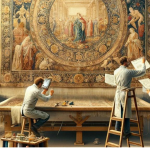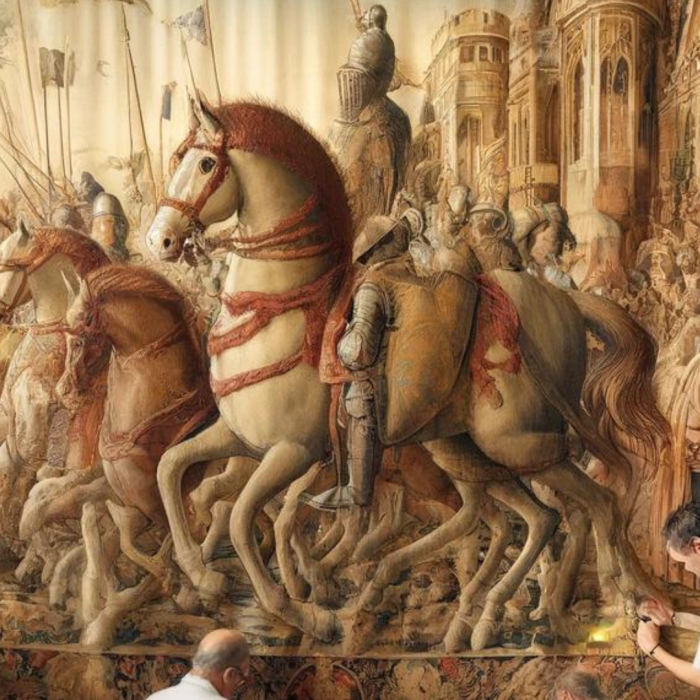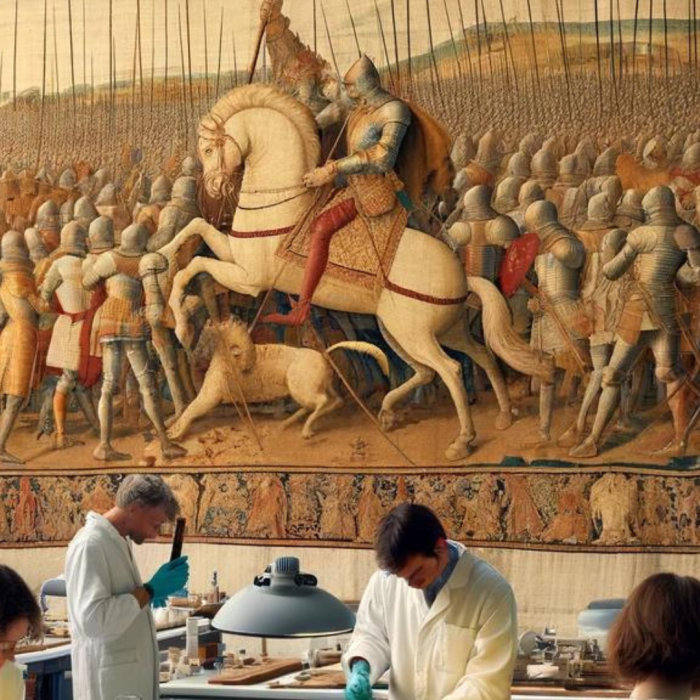Tapestries as a Form of Storytelling
Tapestries as a Form of Storytelling: Weaving Through History
A Glimpse into the Past: Tapestries as Historical Artifacts
Tapestries, with their intricate threads and vibrant colors, serve not just as decor but as a canvas that captures the essence of bygone eras. Originating from the early medieval period, tapestries have been revered as opulent works of art and symbols of prestige. They adorned the walls of castles, churches, and affluent homes, providing insulation while showcasing the wealth and cultural sophistication of their owners.
Historically, tapestries were crafted by skilled artisans who painstakingly wove together threads of various hues to create complex and detailed imagery. These artworks depicted scenes from mythology, religion, history, and daily life, offering a visual narrative of the times and the people. As historical artifacts, tapestries provide invaluable insights into the materials, techniques, and artistic trends of different periods, as well as the societal values and stories deemed important enough to immortalize in thread.
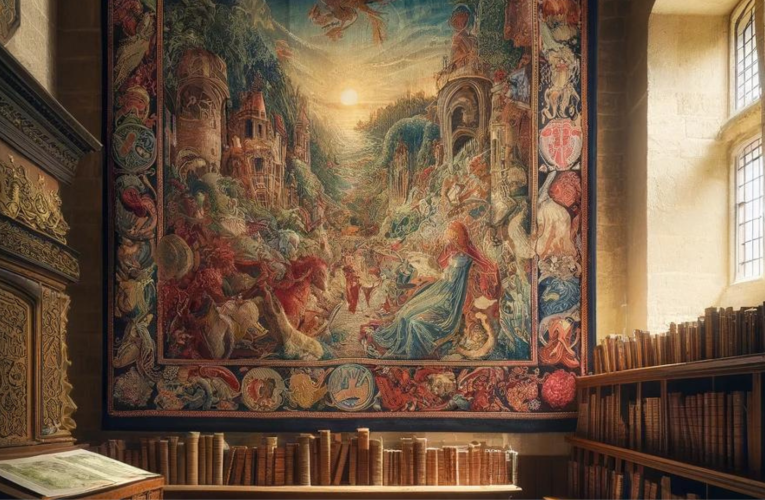
The Narrative Thread: Tapestries and Storytelling
Tapestries have long been used as a medium for storytelling, transcending the limitations of the spoken and written word. This art form enabled artists to weave stories into the fabric, creating a lasting visual record that could be easily transported and shared. Through detailed scenes and symbols, tapestries narrated tales of heroism, love, triumph, and tragedy, making stories accessible to an audience that may not have been literate but could understand and appreciate the visual language of the tapestry.
One of the most famous storytelling tapestries is the Bayeux Tapestry, which chronicles the events leading up to the Norman Conquest of England in 1066. Spanning nearly 70 meters, this embroidered cloth is a historical document that provides a pictorial narrative of the battle, the characters involved, and the cultural context of the era. The ability of tapestries like the Bayeux to capture the complexity of a story in a single, cohesive visual piece is a testament to the power of this medium as a form of storytelling.
Cultural Weave: The Role of Tapestries in Artistic and Cultural Expression
Beyond their narrative function, tapestries have played a significant role in cultural and artistic expression throughout history. They reflect the artistic achievements, technological advances, and cultural aspirations of the societies that produced them. In the Renaissance, for example, tapestries were considered the highest form of art, with famous painters like Raphael designing tapestry cartoons that were then woven by master weavers.
Tapestries also served as a medium for cultural exchange, as designs and techniques spread along trade routes, influencing artistic traditions across Europe, Asia, and beyond. The incorporation of exotic animals, botanical motifs, and mythological themes into tapestry designs reveals a curiosity and appreciation for foreign lands and cultures, contributing to a rich tapestry of global artistic heritage.
Moreover, tapestries have been instrumental in shaping national identities and commemorating historical events. They capture the zeitgeist of the era, reflecting the prevailing ideologies, values, and aesthetics. In this way, tapestries are not just artistic expressions but cultural artifacts that encapsulate the identity and legacy of civilizations.
Tapestries, with their intricate details and rich narratives, have been a vital form of storytelling and cultural expression throughout history. As both artistic masterpieces and historical documents, they provide a unique window into the past, offering insights into the cultural, social, and artistic landscapes of different eras. The legacy of tapestries as a medium for storytelling and cultural reflection continues to inspire artists and audiences today, ensuring that the stories woven into their fabric will be told for generations to come.
The Historical Significance of Tapestries
Tapestries as a Form of Storytelling: Unraveling the Threads of History
Tapestries, with their intricate weavings, have served as a canvas for human expression, capturing the essence of societal values, historical events, and personal stories across various cultures and epochs. This blog post delves into the historical significance of tapestries, exploring their origins in ancient civilizations, their role in medieval Europe as a storytelling medium, and highlighting some of the most famous historical tapestries that have captivated the imagination of generations.
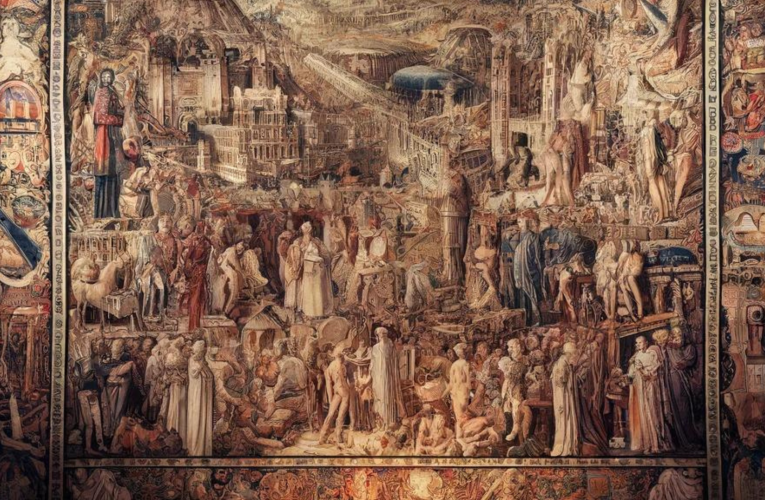
Overview of Tapestries in Ancient Civilizations
Egypt and Peru: Weaving Histories
In ancient Egypt, tapestries adorned the walls of palaces and sacred temples, intricately woven with symbols and images that depicted the pharaohs’ divine authority and the civilization’s religious beliefs. These early tapestries were not only decorative but also served as a medium to immortalize the grandeur of the Egyptian civilization.
Similarly, in ancient Peru, the Incas and their predecessors mastered the art of tapestry weaving, creating pieces that were rich in symbolism and color. These tapestries were more than mere artifacts; they were a form of communication and record-keeping, detailing everything from societal hierarchies to spiritual narratives. The complexity of their designs and the durability of their materials have allowed these ancient tapestries to survive, offering a window into the cultures that created them.
The Role of Tapestries in Medieval Europe as a Storytelling Medium
Chronicles Woven in Threads
In medieval Europe, tapestries transcended their functional use as wall hangings that provided insulation against cold castle walls. They became a vibrant medium of storytelling, portraying legends, biblical tales, and significant historical events. Tapestries were accessible to those who could not read, visually narrating stories that were central to the cultural and religious life of the period.
The art of tapestry weaving flourished in this era, with workshops across Europe producing pieces that were sought after by the nobility and the church. These tapestries were not only prized for their aesthetic appeal and craftsmanship but also for their ability to convey messages and moral lessons, reinforcing the social order and the prevailing values of the time.
Famous Historical Tapestries and the Stories They Tell
The Bayeux Tapestry: A Norman Conquest in Wool
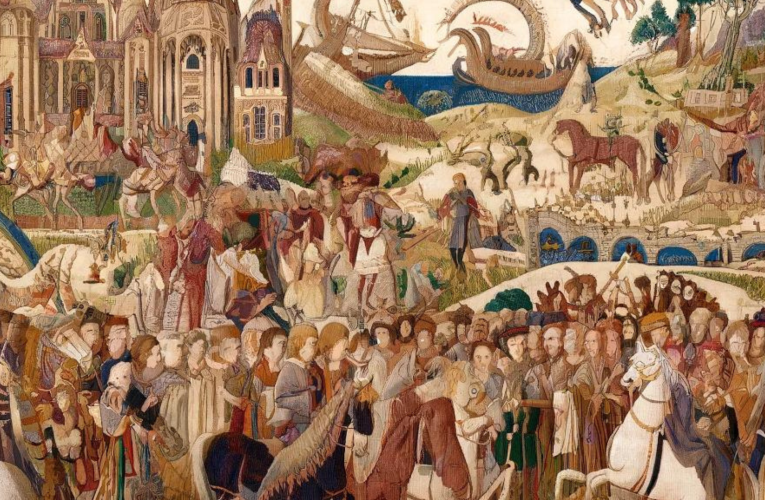
One of the most iconic tapestries in history is the Bayeux Tapestry, an epic recount of the Norman Conquest of England in 1066. This remarkable piece of art stretches over 70 meters long and is intricately embroidered with 50 scenes, narrated in Latin, depicting the events leading up to the Battle of Hastings and its aftermath. The Bayeux Tapestry stands as a testament to the tapestry’s power as a storytelling medium, offering insights into the medieval mindset, warfare, and the socio-political landscape of the 11th century.
The Enduring Legacy of Tapestries
Tapestries continue to fascinate and inspire, serving as a testament to the human desire to record, narrate, and celebrate our histories and myths. From the ancient walls of Egypt and Peru to the castles of medieval Europe, tapestries have woven the rich tapestry of human history itself, reminding us of the power of storytelling and the enduring legacy of art as a mirror to our past. As we unravel the threads of history told through these magnificent works, we gain not only a deeper appreciation for the art of tapestry weaving but also for the stories that have shaped our collective memory.
Techniques and Materials
Tapestries as a Form of Storytelling: Techniques and Materials
Tapestries have served as a magnificent form of storytelling for centuries, weaving together not just threads but also narratives that span cultures, epochs, and geographies. They encapsulate moments in history, mythology, and personal stories with intricate detail and artistic mastery. Understanding the techniques and materials behind tapestry making enriches our appreciation of these textile masterpieces and the stories they tell. This section delves into traditional weaving techniques, the materials used, and how these elements have evolved over time.
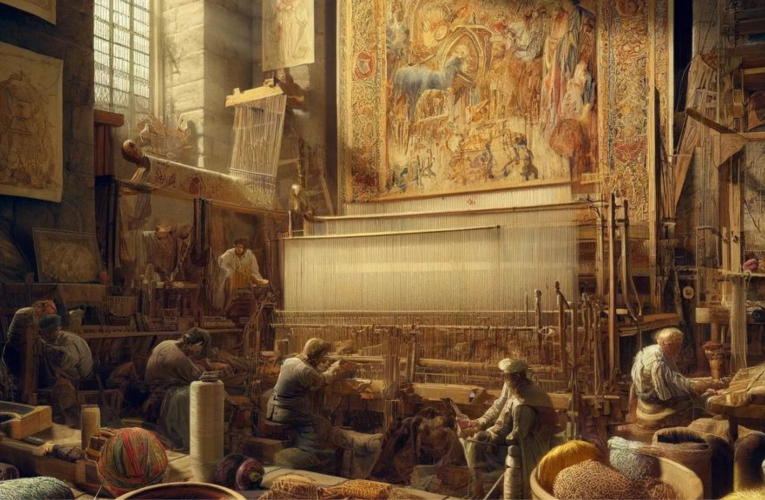
Traditional Tapestry Weaving Techniques
Tapestry weaving is an art form that requires skill, patience, and creativity. Traditionally, tapestries are woven on a loom, a structure that holds the warp threads taut for the weft threads to be woven over and under by hand. This process can vary from simple to complex, depending on the design:
• Plain Weave: The foundational technique of tapestry weaving, where the weft threads cross over and under the warp threads alternately, creating a sturdy and versatile fabric.
• Gobelins Technique: Named after the famous Gobelins Manufactory in France, this method is known for its precision and detail, allowing for the creation of intricate designs and realistic images.
• Aubusson Technique: Originating from France, this technique is similar to the Gobelins but is used to produce large-scale tapestries with a focus on scenic and narrative content.
Materials Used in Tapestry Making
The choice of materials in tapestry making significantly influences the texture, appearance, and longevity of the final piece. Historically, the materials used reflected the tapestry’s purpose, the weaver’s access to resources, and the cultural significance of certain fibers:
- Wool: A common choice for the warp and weft due to its durability, versatility, and wide range of natural colors. Wool tapestries are known for their warmth and depth.
- Silk: Used for its sheen and ability to hold vibrant dyes, silk threads are often incorporated to highlight details or add luminosity to the design.
- Gold and Silver Threads: Used sparingly for embellishment, these materials added luxury and symbolism to tapestries, often seen in works commissioned by royalty or the church.
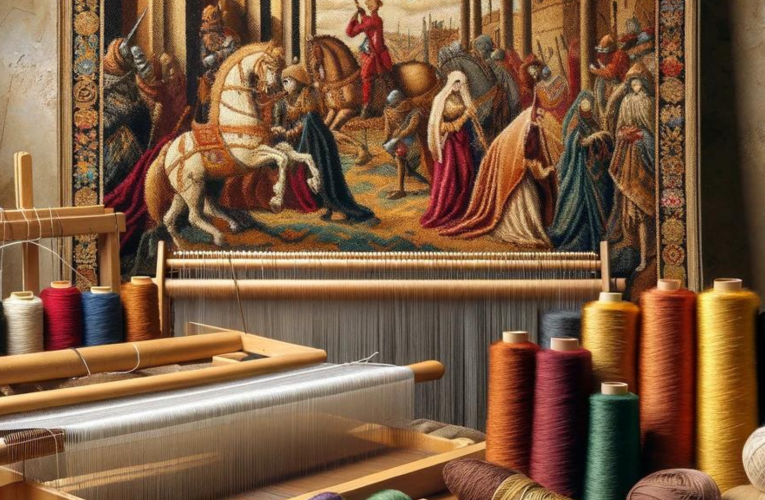
Evolution of Tapestry-Making Techniques Over Time
The evolution of tapestry-making techniques reflects changes in artistic styles, technological advancements, and shifts in social and economic contexts:
- Medieval to Renaissance: The medieval period favored allegorical and religious scenes, woven with simple techniques and a limited color palette. The Renaissance brought advancements in perspective and shading, demanding more sophisticated weaving techniques and a broader range of colors.
- Baroque and Beyond: The Baroque period saw tapestries reaching new heights of drama and complexity, with artists and weavers experimenting with textures and materials to create more dynamic and emotive works.
- Modern and Contemporary: Today, tapestry making embraces both traditional and innovative techniques, including digital weaving and mixed media, expanding the narrative capabilities of tapestries as a form of storytelling.
Tapestries, with their rich blend of art and craft, serve as a canvas for storytelling, capturing the imaginations and realities of their times. The evolution of weaving techniques and materials, from the tactile warmth of wool to the luxurious sheen of silk, reflects not just technological progress but also the shifting currents of human expression. Understanding these aspects of tapestry making allows us to fully appreciate the depth and dimension of the stories woven into their very fabric.
Tapestries as a Narrative Medium
Tapestries as a Form of Storytelling
Tapestries, with their intricate weaves and vibrant threads, have long been a canvas for storytelling, transcending their decorative purpose to serve as a medium for narrative art. This post delves into the historical role of tapestries in depicting significant events, myths, and legends, analyzes the rich symbolism and motifs they embody, and explores their capacity to convey profound social, political, and religious messages.
The Historical Tapestry as a Narrative
Historically, tapestries have been monumental in their ability to capture the essence of societal values, triumphs, and tragedies. They served as visual records of historical events long before the advent of photography, enabling stories to be told and retold through generations. The famous Bayeux Tapestry, for instance, is an epic recount of the Norman Conquest of England in 1066. Stretching over 70 meters, it is a vivid narrative, detailing every significant moment leading up to the Battle of Hastings and its aftermath. Such tapestries provided a means for people of the time to visually engage with their history, making abstract events tangible and comprehensible.
Symbolism and Motifs in Storytelling Tapestries
The art of tapestry weaving incorporates a complex language of symbols and motifs that convey deeper meanings and contexts. Animals, plants, mythical creatures, and geometric patterns are not just decorative; they function as symbols of virtue, power, wisdom, and the divine. For example, the unicorn, often depicted in medieval tapestries, symbolizes purity and grace, while the lion represents strength and authority. The Hunt of the Unicorn tapestry series, which allegorically depicts the hunt and capture of a unicorn, is rich with Christian symbolism, interpreting the unicorn’s capture as the Passion of Christ.
Conveying Messages Through Tapestries
Beyond their aesthetic appeal and narrative capacity, tapestries have historically been potent tools for conveying social, political, and religious messages. They have been used by the ruling elite to assert their authority, celebrate their victories, or propagate ideological and theological narratives. In the Middle Ages and the Renaissance, tapestries adorned the walls of churches, castles, and wealthy households, not just as insulation against the cold but as a statement of power and piety. The Acts of the Apostles series, designed by Raphael for the Sistine Chapel, is a prime example of tapestries used to communicate religious narratives and showcase the splendor of the Papal court.
Tapestries could also serve as a form of political propaganda, subtly or overtly promoting the agenda of those in power. They reinforced hierarchies, commemorated victories, and, at times, illustrated utopian visions of society, thereby influencing public perception and opinion.
Tapestries are a testament to the human desire for storytelling, blending art with history, politics, and religion. As narrative mediums, they offer a unique glimpse into the past, presenting stories that are woven into the very fabric of history. Their intricate designs and motifs go beyond mere decoration to embody the values, beliefs, and aspirations of the people and eras they represent. In the grand tapestry of human culture, each thread tells a story, each color paints an emotion, and each weave brings to life the tales that define us. Through the art of tapestry, we find a form of storytelling that is as rich and complex as the narratives it seeks to tell, providing insight not only into the tales themselves but into the very nature of human expression and communication.
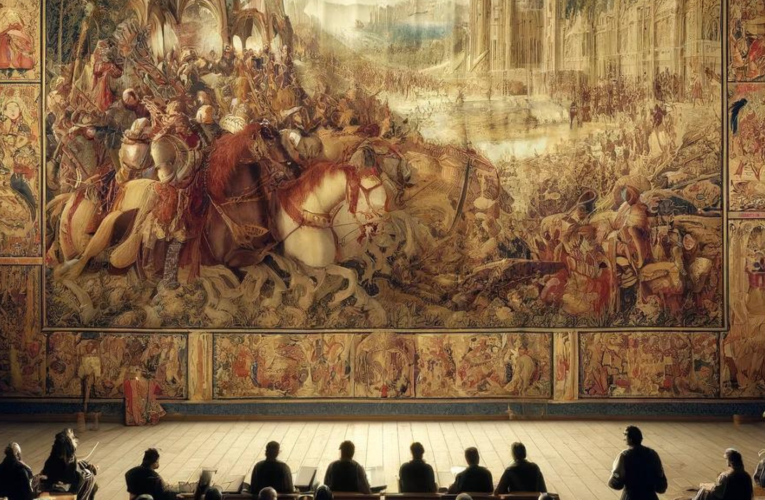
Famous Storytelling Tapestries
Tapestries as a Form of Storytelling: A Journey Through History
Tapestries have long served as a canvas for storytelling, weaving together threads of history, myth, and symbolism to create captivating narratives. Among the myriad of tapestries from different cultures and eras, some stand out for their extraordinary craftsmanship and the stories they tell. This blog post delves into the art of storytelling through tapestries, with a focus on two of the most famous examples—the Bayeux Tapestry and the Unicorn Tapestries—before exploring other notable tapestries from around the world.
The Bayeux Tapestry: A Conquest in Thread
Narrative Technique
The Bayeux Tapestry is an embroidered cloth nearly 70 meters long, depicting the events leading up to the Norman conquest of England and the Battle of Hastings in 1066. Unlike traditional tapestries, which are woven, the Bayeux Tapestry is actually an embroidery on linen, a detail that adds to its uniqueness. Its narrative technique is remarkably sophisticated for its time, employing a linear storytelling method that unrolls the events as if in a modern graphic novel. The use of borders filled with mythical beasts, scenes of everyday life, and fables acts not only as a decorative element but also provides commentary and insight into the culture and beliefs of the period.
Historical Context
The exact origins of the Bayeux Tapestry are shrouded in mystery, though it’s believed to have been commissioned by Bishop Odo, William the Conqueror’s half-brother, in the 11th century. It served not only as an artistic depiction of the conquest but also as a propaganda piece, legitimizing William’s claim to the English throne. The tapestry’s detailed depiction of the battle strategies, ships, armors, and even the comet believed to be an omen for William’s victory, provides invaluable insights into the era’s military and social history.
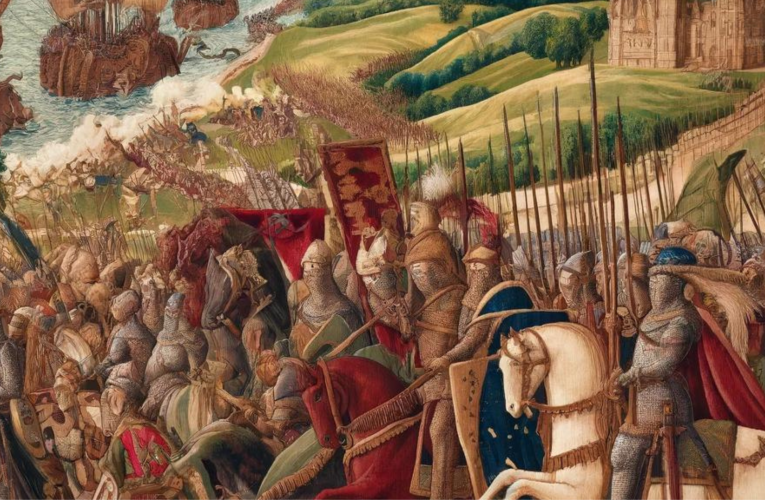
The Unicorn Tapestries: Enigmatic Beauty
Symbolism
The Unicorn Tapestries, a series of seven tapestries from the late Middle Ages, are renowned for their beauty and intricate symbolism, which has been interpreted in various ways. At the surface level, they appear to tell the story of the hunting, capture, and eventual killing of a unicorn, but beneath this narrative lies a rich tapestry of meanings. The unicorn itself is a symbol of purity and grace, often interpreted as Christ in Christian symbolism, with the tapestry’s narrative reflecting themes of suffering, death, and resurrection. The backgrounds teem with a variety of plants, each with its own symbolic meaning, creating a complex allegorical narrative that has intrigued viewers for centuries.
Mysteries Behind the Series
The origins of the Unicorn Tapestries are as mysterious as their symbolism, with little known about who commissioned them or their initial purpose. They are thought to have been designed in Paris and woven in the Netherlands, and they currently reside in The Cloisters museum in New York. The intricate details and symbolism of the tapestries have made them subjects of extensive study and speculation, contributing to their mystique and allure.
Other Notable Storytelling Tapestries
Tapestries have been used as a storytelling medium across various cultures, each adding its own unique threads to the world’s tapestry of narratives:
- The Apocalypse Tapestry: Created in the 14th century, this series of tapestries depicts the story of the Apocalypse from the New Testament, showcasing the dramatic and vivid imagery of Saint John’s visions.
- The Hunt of the Unicorn: Another series that complements the Unicorn Tapestries, these works are believed to symbolize the pursuit of love, with the unicorn representing Christ or purity.
- The Lady and the Unicorn: A series of six tapestries from the late Middle Ages, depicting the five senses along with a sixth tapestry with the inscription “À mon seul désir,” suggesting themes of love and understanding.
Through their intricate weaves, these tapestries tell stories of conquests, legends, and allegories, bridging the gap between art and storytelling. They serve as windows into the past, offering insights into the values, beliefs, and daily lives of the people who created them. Tapestries as a form of storytelling not only decorate walls but also weave the rich tapestries of human history, culture, and imagination.
The Modern Revival of Tapestry Art
The Modern Revival of Tapestry Art: Weaving Stories in Threads
Tapestries, once the narrative canvas of the medieval and Renaissance periods, are experiencing a modern revival that bridges the past and the present. This resurgence in tapestry art is not only a testament to its timeless appeal but also to the innovative ways contemporary artists are weaving stories into their fabric. In today’s world, tapestries are much more than decorative pieces; they are powerful mediums of expression and storytelling.
Contemporary Tapestry Artists and Their Approach to Storytelling
Modern tapestry artists are pushing the boundaries of this ancient craft, infusing it with contemporary themes, personal narratives, and social commentary. These artists, such as Grayson Perry, Kiki Smith, and Erin M. Riley, use tapestries as a canvas to explore complex issues ranging from identity and gender to politics and environmental concerns. Their approach often involves a mix of traditional weaving techniques with modern technology, creating pieces that are rich in texture and depth.
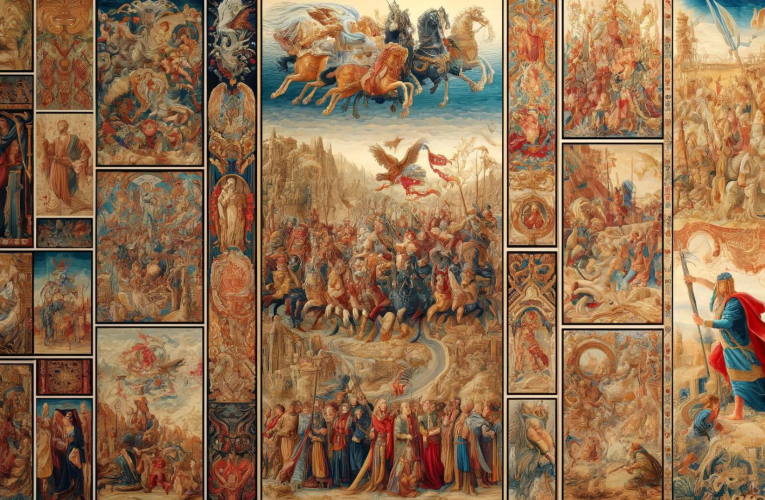
Grayson Perry
Grayson Perry, for example, utilizes tapestries to explore the landscape of modern British society, combining vibrant imagery with poignant commentary on class, taste, and social mobility. His tapestries are large-scale, drawing viewers into a detailed and dynamic narrative.
Kiki Smith
Kiki Smith, on the other hand, uses tapestry to delve into themes of nature, mythology, and femininity. Her work often features animals, humans, and celestial bodies, woven together in a way that feels both ancient and deeply personal.
Erin M. Riley
Erin M. Riley brings a more autobiographical approach to her tapestries, addressing personal history, trauma, and the female experience in the digital age. Her works are striking for their use of color and pattern, as well as their candidness.
The Influence of Traditional Techniques on Modern Tapestry Making
Contemporary tapestry artists often draw inspiration from traditional weaving techniques, even as they experiment with new materials and methods. This reverence for the craft’s history is evident in the way artists incorporate age-old methods into their work, ensuring that the essence of tapestry making—a meticulous and time-consuming process—is preserved.
These modern weavers are also contributing to the craft’s evolution by incorporating unconventional materials, such as recycled fabrics and digital imagery, into their designs. The fusion of traditional and contemporary techniques not only enriches the texture and complexity of the tapestries but also bridges the gap between past and present storytelling methods.
How Modern Tapestries are Used to Tell Stories and Convey Messages in Today's World
Today’s tapestries transcend decorative art; they are potent vehicles for storytelling and social commentary. Artists weave narratives that reflect on personal experiences, societal changes, and global issues, making each piece a tapestry of ideas and emotions.
Storytelling Through Imagery and Texture
The imagery in modern tapestries often incorporates symbols, motifs, and scenes that narrate stories or highlight issues. The texture and depth of the weave add layers of meaning, creating a tactile experience that enhances the visual narrative.
Tapestries as Social Commentary
Many contemporary tapestries serve as a form of social commentary, reflecting on issues like climate change, social justice, and human rights. Through their work, artists invite viewers to reflect on the world around them, sparking dialogue and encouraging change.
Personal and Collective Narratives
Modern tapestries also serve as a medium for personal expression and collective narratives, weaving together individual stories with broader societal themes. This intersection of the personal and the political in tapestry art makes it a powerful tool for storytelling in today’s world.
The modern revival of tapestry art highlights the enduring appeal and versatility of this ancient craft. As contemporary artists blend traditional techniques with modern narratives, tapestries continue to be a vibrant and compelling medium for storytelling, connecting threads of the past with the tapestry of modern life.
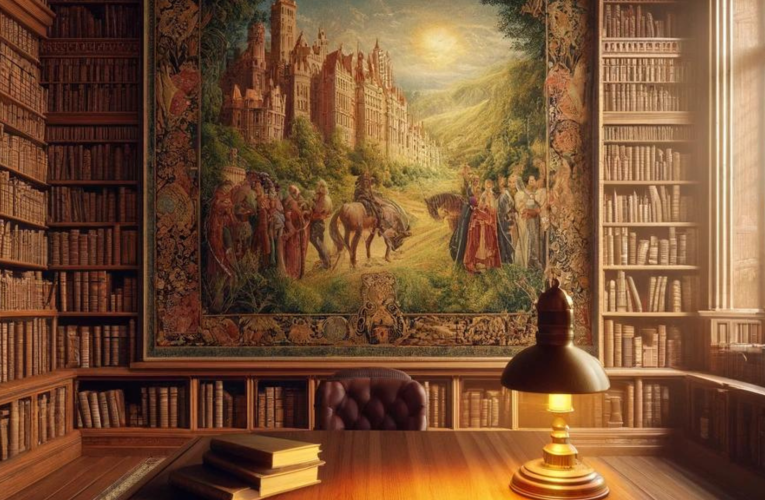
The Role of Tapestries in Spaces
Decorating with Depth
Tapestries do more than just adorn a wall; they add a layer of depth and texture to a space that few other art forms can. In public buildings, such as libraries, museums, and government buildings, tapestries can communicate cultural heritage, historical events, or societal values. In homes, they add warmth and character, turning a blank wall into a conversation piece that reflects the homeowner’s tastes, interests, or personal history.
Adding Meaning
Beyond their aesthetic appeal, tapestries in both public and private spaces serve as a canvas for storytelling. They can depict mythological scenes, historical events, landscapes, or abstract themes that resonate with viewers on a personal level. This capacity to convey complex narratives and emotions makes tapestries uniquely powerful in creating an engaging atmosphere in any setting.
Contemporary Storytelling Tapestries
Modern tapestries continue the tradition of storytelling, with artists and commissions focusing on contemporary themes and personal narratives. Here are a few notable examples:
• Commemorative Tapestries: Many institutions commission tapestries to commemorate significant events or anniversaries. For example, the United Nations has commissioned tapestries to celebrate peace and cultural diversity, each telling the story of humanity’s hope for a better future.
• Personal Narratives: Artists today create tapestries that tell personal stories or explore identity, often blending traditional techniques with modern themes. These works can be profoundly personal, offering a glimpse into the artist’s life or reflecting broader social and cultural narratives.
• Public Art Projects: Cities and communities sometimes commission tapestries as part of public art initiatives, using them to beautify spaces and foster a sense of community identity. These tapestries often tell the story of the area’s history, cultural diversity, or aspirations.
Selecting a Storytelling Tapestry
Choosing a tapestry that tells a story for your space involves several considerations:
• Theme and Narrative: Decide on the kind of story you want to tell. Do you want a tapestry that reflects your personal history, cultural heritage, a favorite mythological tale, or an abstract theme?
• Style and Technique: Tapestries come in various styles and techniques, from handwoven to digitally printed. Consider which style resonates with you and suits the space where the tapestry will hang.
• Color and Size: The tapestry’s color should complement the room’s existing palette, while its size should be appropriate for the intended wall. A large, bold tapestry can be a focal point, while smaller pieces can add accents or form part of a gallery wall.
• Artist and Provenance: Supporting contemporary artists or artisans can add a layer of meaning to your tapestry. Knowing the story behind who made it and why can make the tapestry even more special.
Tapestries have the unique ability to envelop spaces in stories, transforming walls into windows to other times, places, and narratives. Whether through the depiction of historical events, personal stories, or abstract themes, tapestries continue to be a powerful medium for storytelling in both public spaces and homes. When selecting a tapestry, consider what stories you want to surround yourself with and how those stories complement the function and aesthetic of the space they inhabit.

